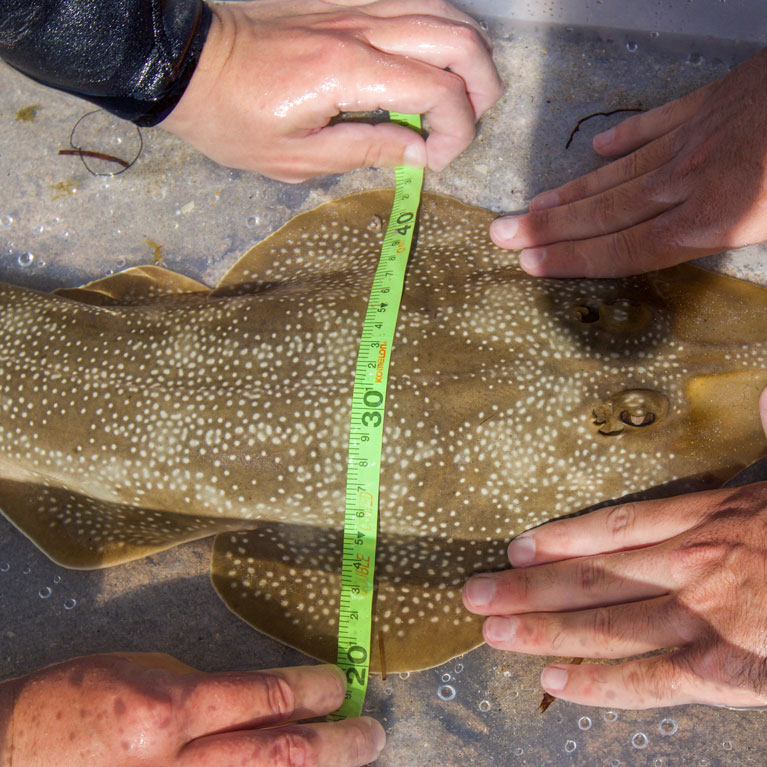Who’s eating who? Atlantic guitarfish and the food web
Almost nothing is known about the Atlantic guitarfish; there is very little in the literature about this species, which belongs to a most vulnerable group of shark-like rays. But understanding its basic biology and ecology is essential. John believes a lack of compassionate PR for this ‘less charismatic’ kin of the sawfish is to blame for the relatively little attention paid to efforts to conserve it and aims to figure out where it fits in the food web. Understanding the trophic ecology of the Atlantic guitarfish – what it eats and who eats it – will help to identify essential habitat areas and important resources that can better guide conservation management.
My most vivid childhood memories involve the ocean and marine wildlife: seeing my first shark while snorkelling in the Florida Keys; vacationing as a family at the beach; and spending countless hours surrounded by the myriads of fish at the National Aquarium. Growing up in a Northern Virginia suburb of Washington, D.C., meant being close enough to make trips to the coast not too difficult but still far enough away to make them special. My fascination eventually matured into a career aspiration. From the moment of that decision onward, I focused on becoming a marine biologist. Despite a...


Trophic ecology and population genetic structure of South Florida’s Atlantic guitarfish (Pseudobatos lentiginosus)
The primary objective of this project is to characterise the diet and trophic role of Atlantic guitarfish in the ecosystem of the highly impacted South Florida coast to better inform conservation of this at-risk species.
Guitarfish are a highly exploited but understudied group of elasmobranchs, and species such as the Atlantic guitarfish are almost completely absent from recent literature. Addressing this lack of information is of paramount importance, given the population declines and red-flag conservation status of many species, including the Atlantic guitarfish. An in-depth understanding of the trophic ecology of this species will help direct conservation efforts towards critical resources within highly impacted coastal habitats.
The Atlantic guitarfish Pseudobatos lentiginosus, a benthic shark-like ray that inhabits the shallow coastal waters of the Western Atlantic, Gulf of Mexico and Caribbean, is classified as Vulnerable by the IUCN. Around the world, guitarfish are exploited in targeted fisheries for their meat and fins and are commonly encountered as fisheries bycatch. Like their sawfish relatives, guitarfish experience many human-induced threats associated with their dependence on near-shore habitats. Unlike sawfish, however, they lack charisma to rally research and legislation to their defence. As a result, the ecology of many species remains largely unexplored. Guitarfish are often regarded as both an influential benthic predator and a key prey item for larger sharks, thus serving as an important energetic link between benthic production and upper-level consumption. Research on two guitarfish species shows they can occupy diverse trophic positions from mid- to top-level predators, but the role of Atlantic guitarfish in the trophic functioning of coastal ecosystems has yet to be investigated. Therefore, to address this knowledge gap in the context of the challenges imposed by coastal residency, this study undertakes to characterise the diet and trophic niche of Atlantic guitarfish by employing the complementary methodologies of stable isotope analysis, stomach content analysis and DNA meta-barcoding. By identifying the resources critical to Atlantic guitarfish, this study hopes to inform guitarfish conservation and ecosystem-based management of the habitats along the highly urbanised South Florida coast.
- To characterise the diet and trophic niche of Atlantic guitarfish in South Florida.
- To identify high-priority habitats and resources for Atlantic guitarfish conservation along an urbanised coastline.

